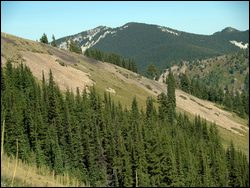 The Coeur d'Alene River Ranger District originated as the Coeur d'Alene Forest Reserve, created by President Teddy Roosevelt on November 6, 1906. It soon came under the administration of the newly created U.S. Forest Service and continued as the Coeur d'Alene National Forest. In 1973 the Forest Service consolidated the Coeur d'Alene National Forest with the Kaniksu and St. Joe National Forests under the administrative title "Idaho Panhandle National Forests" and its' several Ranger Districts were ultimately combined to form a single Ranger District under its' current title.
The Coeur d'Alene River Ranger District originated as the Coeur d'Alene Forest Reserve, created by President Teddy Roosevelt on November 6, 1906. It soon came under the administration of the newly created U.S. Forest Service and continued as the Coeur d'Alene National Forest. In 1973 the Forest Service consolidated the Coeur d'Alene National Forest with the Kaniksu and St. Joe National Forests under the administrative title "Idaho Panhandle National Forests" and its' several Ranger Districts were ultimately combined to form a single Ranger District under its' current title.
The Ranger District is administered from two offices: the Fernan office located in Coeur d'Alene, and the Silver Valley office located in Smelterville.
The Coeur d'Alene River Ranger District has a storied history centered around the mining of its' vast silver reserves and the 1910 fire which consumed vast acreages of its' valuable timber stands - over 3 million acres total in Idaho and Montana. The 1910 fire focused the nation's attention on the Forest Service's Region One and over time the Region became the Forest Service's center for experts on wildland fire.
Of the many stories that came out of the 1910 fire, perhaps none is as compelling as Ranger Pulaski's desperate flight down the West Fork of Placer Creek with 45 other men. As the flames began to overtake them, Pulaski shepherded them into the Nicholson adit where he ordered them to the back of the tunnel, threatening to shoot any man who ventured out. Pulaski wetted horse blankets and guarded the adit's entrance to keep fire from burning its support timbers. All the men were rendered unconscious by the heat, smoke and fumes. In the end, all but five men regained consciousness. As they crawled to the creek, they found it hot and alkaline with ash. They struggled but finally make it to Wallace. Pulaski's name lives on as the versatile firefighting tool he later designed. A few remnant snags left over from the fire are still visible on parts of the Coeur d'Alene River and St. Joe Districts.
Today, the Coeur d'Alene River Ranger District has reforested, but mostly gone are the vast stands of white pine that attracted loggers from the depleted forests of the midwest. The white pine succumbed to a european fungus known as blister rust and was replaced in many areas with a combination of douglas-fir and grand fir. While logging continues on the district, more and more people are discovering the recreational treasures the district offers. It's proximity to the greater metropolitan area of Spokane, Washington makes it a favored destination for people seeking to escape to the woods for a few hours to a few days.
DISTRICT INFORMATION
- Brochures
- America the Beautiful Pass
- District Recreation site information (scroll down below map for activities)
- Cabin and Lookout Rental information
- Firewood Permits
- To report a fire, call the Coeur d'Alene Dispatch Center at: (208) 772-3283.
Alerts & Warnings
- Flat Creek Forest Road 462A Closure, Priest Lake Ranger District
- Catspur Creek Road and Area Closure, St. Joe Ranger District,
- Ridge Creek Salvage Sale Road Closure, CDA River Ranger District
- Hiawatha Rail Trail Closure, St. Joe Ranger District
- Huckelberry Trail #802 Closure, CDA River Ranger District
- Green Bay Closure, Sandpoint Ranger District
- Solo Creek Quartz Dig Site Closure, Priest Lake Ranger District
- Chilco Mountain Trail Closure, CDA River Ranger District
- Kootenai River Complex Closure, Bonners Ferry Ranger District

